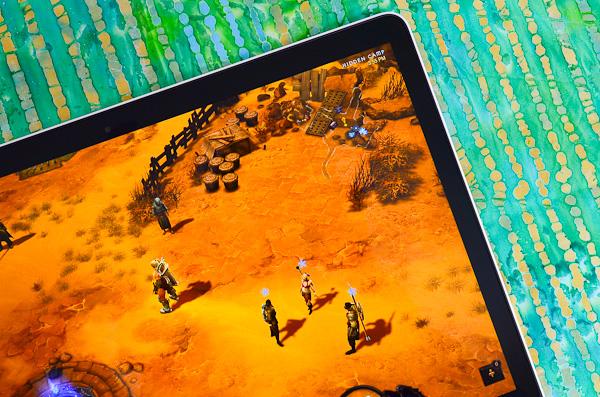The next-gen MacBook Pro with Retina Display Review
by Anand Lal Shimpi on June 23, 2012 4:14 AM EST- Posted in
- Mac
- Apple
- MacBook Pro
- Laptops
- Notebooks
Achieving Retina
To make the MacBook Pro’s Retina Display a reality Apple had to work with panel vendors to build the panels it wanted at a reasonable cost, as well as deliver the software necessary to support insanely high resolutions. There was another problem Apple faced in making the rMBP a reality: the display pipeline of the GPUs Apple wanted to use didn't officially support scaling to the resolution Apple demanded of them. Let me explain.
All modern GPUs have fixed function scaling hardware that is used to efficiently scale between resolutions. A scaler either in your GPU or in your display panel is what lets you run non-native resolutions at full screen on your LCD (e.g. running 1680 x 1050 on a 1920 x 1080 panel). None of the GPUs used in the Retina Display MacBook Pro officially support fixed-function scaling of 3840 x 2400 or 3360 x 2100 to 2880 x 1800 however. Modern day GPUs are tested against 2560 x 1440 and 2560 x 1600, but not this particular 5MP resolution. Even 4K resolution support isn’t widespread among what’s available today. Rather than wait for updated hardware and/or validation, Apple took matters into its own hands and built its own GPU accelerated scaling routines for these higher resolutions. Fixed function hardware is almost always more efficient from a performance and power standpoint, which is why there’s some additional performance loss in these scaled resolution modes.
What’s even crazier is Apple wasn’t pleased with the difference in baseline filtering quality between the Intel HD 4000 and NVIDIA GeForce GT 650M GPUs. As the Retina Display MacBook Pro would have to regularly switch between GPUs, Apple wanted to ensure a consistently good experience regardless of which GPU was active. There are a lot of filtering operations at work when doing all of this resolution scaling, so rather than compromise user experience Apple simply wrote its own default filtering routines. Since you want your upscale and downscale quality to be identical, Apple had to roll its own implementation on both. Apple’s obsessive attention to detail really made it possible to pull all of this off. It’s just insane to think about.











471 Comments
View All Comments
vision33r - Sunday, June 24, 2012 - link
When a PC laptop goes on sale, the listed price is never the actual purchase price.A $1000 Dell usually end up getting sold for $800 or less after coupons and Dell runs sales all the time. Same goes for HP.
Apple almost never do a sale until the model is outdated, the only discount is the education one.
It's a certain that all PC laptop makers have to cut corners to make a profit, competition is fierce. Most buyers are more price sensitive these days then specs.
duploxxx - Monday, June 25, 2012 - link
Many manufacturers allow options in there designs towards more cutting edge technology...I have a full HD display in a 15"since 2008, same for my SSD.... just a matter of cutting cost for low profile. This differentiate with apple who already put these in the baseline... call bleding edge wathever you want but I am sure my Laptop cost probably a few 100$ less with eluminated keyb, optimus etc.... but it hasbn't got the shiny apple logo :)
Johnmcl7 - Saturday, June 23, 2012 - link
Sony have been offering 13.1 1920x1080 screens for a few years which admittedly isn't nearly as high as the new Macbook screen but given Sony have been frequently criticised for offering such a pointlessly high resolution it's little surprise they haven't developed it further.When Apple do it however they get praised for their innovation and bringing the market forward when in reality they're a while behind other companies who are genuinely innovative and getting the technology out there.
John
Super56K - Saturday, June 23, 2012 - link
I'm not sure you understand. It's rendered at double the resolution, but presented at the same size as 1440x900 or 1900x1200 on a 15" screen. You gain clarity rather than real estate.What other notebooks out there can do that?
ananduser - Saturday, June 23, 2012 - link
Lol...you just described DPI scaling. The retina mb just offers ready made presets. To achieve the same effect on the Z simply change the DPI scaling within the native resolution.KoolAidMan1 - Saturday, June 23, 2012 - link
Scaling in Windows doesn't work the same, nor is it targeted towards such specific resolutions. Anand talks about this himself in the review.Hopefully Windows 8 outside of the Metro UI addresses this.
OCedHrt - Sunday, June 24, 2012 - link
That's because Windows only goes up to 1.5 instead of 2. But at 1920x1080, 1.5 gives you 1280 x 720. Do you really want to go that small?ananduser - Sunday, June 24, 2012 - link
OMG...it's been said 10 times already in the comments. Windows goes all the way up to 200%. Anand does not know Windows setting well enough.ananduser - Sunday, June 24, 2012 - link
That't the idea, scaling should *NOT* be dependent on specific resolutions. It should be agnostic. That's what Windows does because it's supposed to power the world's computers, macs included.dagamer34 - Sunday, June 24, 2012 - link
Windows 8 addresses this by providing an easy way to serve up high resolution assets for the OS to use depending on the DPI of the machine. It takes all of the guesswork out of the developers hands with no extra code needed.